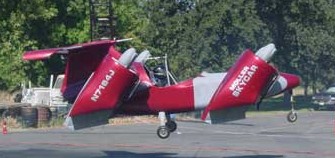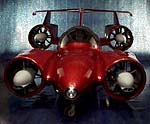In an unrelated post dated November 15, 2005, I wrote:
As a lad growing up in the 1970’s, I simply assumed that by the year 2000, we would all own flying cars.
We don’t, and I’m kinda pissed about that.
Well, guess what? They’re coming!!!!
Moller International has developed the first and only feasible, personally affordable, personal vertical takeoff and landing (VTOL) vehicle the world has ever seen.
You’ve always known it was just a matter of time before the world demanded some kind of flying machine which would replace the automobile. Of course, this machine would have to be capable of VTOL, be easy to maintain, cost effective and reliable. Well, we at Moller International believe we have come up with the solution. That solution is the volantor named M400 Skycar.
Cool.
From your garage to your destination, the M400 Skycar can cruise comfortably at 275 MPH (maximum speed of 375 MPH) and achieve up to 20 miles per gallon on clean burning, ethanol fuel. No traffic, no red lights, no speeding tickets. Just quiet direct transportation from point A to point B in a fraction of the time. Three dimensional mobility in place of two dimensional immobility.
Way cool. Awesome. But a crusing speed of 275 MPH? Uh, what about safety issues?
Dual Engines — In the unlikely event of an engine failure sufficient power remains to ensure a safe and comfortable landing. Since the M400 has eight engines, one or more can fail and the Skycar will still operate safely. Unlike any light helicopter or airplane, the M400 Skycar has four engine nacelles; each with two Rotapower engines. These computer-controlled engines operate independently and allow for a vertical controlled landing should one engine fail.
Okay. I’m not nuts about an engine failing, but if I’ve got eight of them — well, eight is enough.
Redundant Computer Stabilization Systems — The Skycar has redundant, independent computer systems for flight management, stability and control. Should a computer problem occur backup systems would take over seamlessly. M400 has multiple independent computers for flight management and the design prevents a single-point failure from adversely effecting the performance of the aircraft.
Well, as long as the computer isn’t Windows-based, I guess I’m okay with this.
Dual Parachutes — Even in the instance of complete power loss you and your passengers are protected. The two airframe parachutes, front and rear, will guide the volantor safely and comfortably to the ground without incidence and can be deployed in the event of a critical failure of the aircraft. With the parachutes, the pilot, passengers and the Skycar can be recovered safely. Parachutes developed for the ultra-light aircraft industry, that are ballistically ejected, have demonstrated reliable vehicle recovery above 150 feet.
 P-p-p-p-p-parachutes? Ummmmm. Parachutes. I’m not encouraged by the fact that two parachutes will guide my flying car to the ground "without incidence". It seems to me that if the parachutes are deployed, I am already experiencing an "incidence".
P-p-p-p-p-parachutes? Ummmmm. Parachutes. I’m not encouraged by the fact that two parachutes will guide my flying car to the ground "without incidence". It seems to me that if the parachutes are deployed, I am already experiencing an "incidence".
Okay. Well, assuming the FAA approves this (fat chance), what’s the price tag?
$995,000 for one of the first ones of the line.
Um, I like roads. I just realized that. I really like them.

